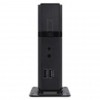ViewSonic SC-T35 SC-T35 / SC-T45 ViewSonic Device Management (English) - Page 66
Pushing Settings to Clients through Your Local Network
 |
View all ViewSonic SC-T35 manuals
Add to My Manuals
Save this manual to your list of manuals |
Page 66 highlights
Using ViewSonic Device Manager Managing All Your Clients 3.4.15 Pushing Settings to Clients through Your Local Network The Push Settings feature enables you to sync up client configuration on a client with the one set up in remote ViewSonic Device Manager. You can then configure client settings remotely through your local network. NOTE • Some settings can only be configured locally on clients. See section "3.4.8 Client Settings" on page 48 and chapter 4 "Configuring Client Settings" on page 100 for more details. Pushing Settings to a Client To push settings to a client, please do the following: NOTE • To ensure that your ViewSonic Device Manager is in sync with the setting values on managed clients, it's recommended to pull client settings from all managed clients for ViewSonic Device Manager before editing individualized client settings. For detailed instructions on how to pull client settings from managed clients, please refer to section "3.4.16 Pulling Client Settings through Your Local Network" on page 65. 1. On Thin Clients tab, click Thin Clients to expand the Client Group tree, and then click the client group to which the desired client belongs. 2. The Client list appears. 3. Click to select the desired client, and then click Command on the top of the Client list. NOTE • To select more than one client, Ctrl-click to select the desired clients. • Ensure that all selected clients are powered up. Otherwise, you may fail to push settings to some clients. You can remotely know the current status of a client through the Status icon in front of the client. For information on the Status icons, please refer to section "3.4.7 Understanding Client Status Icons" on page 47. 61















